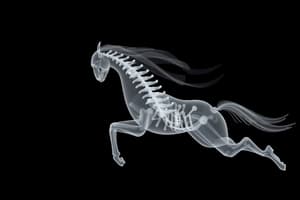Podcast
Questions and Answers
What is position?
What is position?
Variable that tells location relative to an origin.
What is the origin?
What is the origin?
A place where the position has been given a value of zero.
What is speed?
What is speed?
How quickly an object moves, calculated by dividing distance by time.
What is average speed?
What is average speed?
What is instantaneous speed?
What is instantaneous speed?
What is a vector?
What is a vector?
What is velocity?
What is velocity?
What is an axis?
What is an axis?
What are coordinates?
What are coordinates?
What is constant speed?
What is constant speed?
What is slope?
What is slope?
What is acceleration?
What is acceleration?
What is free fall?
What is free fall?
What is acceleration due to gravity?
What is acceleration due to gravity?
What is a projectile?
What is a projectile?
Study Notes
Key Concepts in Motion
-
Position: Indicates an object's location relative to a defined origin, essential for understanding movement.
-
Origin: The reference point where the position is assigned a value of zero, serves as a baseline for measurement.
-
Speed: Measures how fast an object moves, calculated with the formula Speed = Distance/Time (D/T).
-
Average Speed: Calculated by dividing the total distance traveled by the total time taken for the entire trip, providing a general overview of motion.
-
Instantaneous Speed: Represents the speed of an object at a specific moment, highlighting real-time motion characteristics.
-
Vector: A variable that incorporates both magnitude and direction, crucial for fully understanding motion dynamics.
-
Velocity: Similar to speed but also includes direction; it communicates how fast and in what direction an object is moving, a vector quantity.
-
Axis: A component of a graph consisting of one or more number lines, used to plot values in a coordinate system.
-
Coordinates: Sets of values that specify a position concerning the origin, crucial for identifying locations within a given space.
-
Constant Speed: Describes motion where the speed remains unchanged over time, indicating uniform movement.
-
Slope: A graphical representation that defines the ratio of the vertical rise to the horizontal run, important for analyzing relationships between variables.
-
Acceleration: The rate at which velocity changes over time, a key factor in understanding how quickly an object speeds up or slows down.
-
Free Fall: Motion experienced by an object solely under the influence of gravity, without any other forces acting on it.
-
Acceleration Due to Gravity: A constant value of approximately 9.8 m/s² at Earth's surface, denoting the rate of acceleration for free-falling objects, represented as 'g'.
-
Projectile: An object that is propelled through space and is influenced only by gravitational forces, essential in studying motion in two dimensions.
Studying That Suits You
Use AI to generate personalized quizzes and flashcards to suit your learning preferences.
Description
Test your knowledge of key terms related to motion with these flashcards from Chapter 4. Learn definitions for essential concepts like position, speed, and average speed. Perfect for quick review or study sessions before exams.




